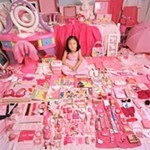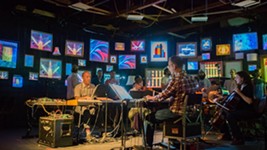Residence = Difference
A Stay at ArtPace in San Antonio Can Change an Artist
By Rebecca S. Cohen, Fri., June 13, 1997
|
|
Founder Linda Pace and ArtPace director Laurence Miller, former director of Laguna Gloria Art Museum (now Austin Museum of Art), have announced that Central Texas artists will compete with San Antonio area artists for the regional residency at ArtPace during the next cycle. Rather than vying with artists from across the U.S., those from Austin and environs will be considered from a much smaller pool of contenders for the 1999-2000 slots. In a two-year pilot program, ArtPace will investigate the impact of expanding the IAIR program beyond South Central Texas in an effort to broaden regional dialogue about contemporary art and fine-tune the IAIR concept.
Would-be residents may not apply directly but are chosen through a long and complex process. Nominators - arts professionals from throughout the world - are contacted by ArtPace and asked to submit artists' names. Only those pre-selected artists are asked to send ArtPace their slides, which are then considered by a prestigious independent panel of artists, curators, collectors, and arts professionals convened in San Antonio for that purpose. In addition, each year a leading curator is invited to select all three artists for one residency period. In the past, these individuals have included Robert Storr, a curator from New York's Museum of Modern Art (MOMA), and Maaretta Jaukkuri, Chief Curator of the Museum of Contemporary Art, Helsinki, Finland. The next curator to participate will be Susanne Ghez, Director of the Renaissance Society at the University of Chicago. Even the "losers" benefit from studio visits by curators of this caliber.
For each of its IAIR cycles, ArtPace invites one regional artist, one artist from elsewhere in the United States, and one artist from outside the U.S. to live and work at its studio/exhibition facility in San Antonio for up to two months. Artists are provided with travel expenses, a weekly living stipend, a generous materials budget, an apartment, and studio/exhibition space, as well as access to a fully equipped wood, metal, and computer graphic design workshop. The foundation's largesse allows artists to realize projects that they might not otherwise tackle for lack of funds or adequate studio space. Following the residency, the IAIR artists are provided with a one-month exhibition accompanied by a small exhibition brochure. This guarantees access to the work for the local community and an ever-expanding audience of sophisticated art tourists. All projects made during the residency belong to the artist, who is encouraged to present slide lectures and engage in a dialogue with the San Antonio art community.
An ArtPace residency can alter an artist's career, refine his or her point of view, and expand personal horizons. I interviewed five San Antonio artists to find out how their participation in the IAIR program affected them. (The numerical "code" following each artist's name indicates the year and quarter in which they were in residence.)
Jesse Amado (95.1) both benefited and suffered from being the first San Antonio resident. He was chosen to take part in the program by MOMA's Robert Storr, who also selected Annette Messager (Paris, France) and Felix Gonzales-Torres (New York City). By virtue of those associations and being part of the inaugural exhibit, Amado received significant publicity and a huge audience outside his hometown. Unfortunately, Messager and Gonzales-Torres spent very little time in residence prior to the opening, allowing him minimal interaction with them, and Amado's own presence at ArtPace was often overshadowed by activities surrounding the start-up of the program. Toward the end of 1996, however, Amado presented a one-person exhibition at Houston's Contemporary Art Museum - a significant showcase for contemporary work - which was underwritten in part by ArtPace. The artist praises the foundation's ongoing interest in advancing the careers of its participants beyond San Antonio.
Ken Little (95.4) came to ArtPace already a veteran recipient of grants and fellowships. He'd received three major grants from the National Endowment for the Arts and fellowships from the John Michael Kohler Art Center's Arts/Industry program, among others. The ArtPace residency, he says, allowed him to continue the work he was already doing and develop his ideas quickly. He produced a site-specific installation consistent with his signature style for ArtPace, then used elements of that installation, rearranged and reconsidered, in his next large work elsewhere. Little turned the gallery upside down, floating houses near the ceiling and building a clay figure (that looked vaguely like chocolate, lit from within) on the floor. Huge blue neon hands on the wall signed an ambiguous message.
During his residency, Little continued to teach at UT San Antonio (UTSA) and maintain his personal studio at Rose Amarillo, a warehouse where he also leases space for studios to other artists and maintains an active gallery. Small wonder that he didn't really get to know the artists whose work was exhibited with his. But even if regional artists both live and work full-time at ArtPace, enhancing the odds of interacting with other residents, there still is no guarantee of long-term bonding. "Leonardo Drew (Brooklyn, New York) came and went," says Little. "Cisco Jimenez (Cuernavaca, Mexico) worked for two months in residence, but he really worked." It has apparently proved easier for San Antonio artists to get to know every artist but the ones with whom they work concurrently on ArtPace projects. The effort involved in completing the project at hand seems to rule out a lot of socializing.
Ken Little also lauds the IAIR program for the opportunity it provides artists to meet visiting curators and the research and development support it offers. He points out that international and national artists also get boosts through the residencies. "Not only local artists are on an upward trajectory," he says. All the players are in flux.
Elizabeth McGrath (96.1) has been on a speedy upward trajectory as a direct result of her interaction with ArtPace. She had just completed her MFA degree at UTSA when she was chosen for the London Studio Program also sponsored by the foundation. Eugene Binder, former curator at Laguna Gloria Art Museum and a longtime commercial art dealer who runs a New York gallery, was on the panel that selected McGrath for the London program. He offered her representation soon after visiting her studio. "Being with Gene has changed my perspective more than ArtPace," admits McGrath, whose aspirations for her work have more to do with making than marketing. She still hasn't quit her day job as waitress.
May Sun (Venice, California) and Leni Hoffman (Nuremberg, Germany) shared McGrath's residency period. "I got to know May because she was there almost the entire time," notes McGrath, who says the two still stay in touch. Hoffman appeared two weeks before and stayed for two weeks after the exhibition opening. Both visitors were used to realizing large, expensive projects, while McGrath had been making intimate objects from rubber and fiber, scrounging for materials, making do. At first, she was intimidated by the $10,000 budget offered by ArtPace and asked a friend for advice. "Spend it," he replied. The artist says the experience changed her notion that having money would assure better work.
Perhaps one of the most direct benefits of the residency for McGrath was the small jewel of a catalogue produced by ArtPace with an essay by McGrath's friend, San Antonio artist-writer Hills Snyder. His description of her work is both playful and keen. He has since contributed one of two essays for a more in-depth catalogue produced by Eugene Binder. Snyder is also studio assistant at ArtPace.
Alex de Leon (96.2) works part-time at ArtPace, too. Providing employment for San Antonio artists seems to be another major contribution the foundation has made. (It has also employed arts writers, including this one on occasion, to prepare press releases and artists' catalogues.) In addition to supplementing income, jobs guarantee access to visiting artists by non-residents. "You learn from others," de Leon says. Dorothy Cross (Dublin, Ireland) and Lewis de Soto (San Francisco, California), however, who shared his time slot at ArtPace were in residence for only two weeks. The access to and chemistry between international, national, and regional artists seems to depend on the "luck of the draw."
De Leon speaks of his own residency with buoyant enthusiasm. "It was one of the best experiences of my life. I can't say it was my best show, but I learned from it." The ability to dive headlong into a project without having to "succeed" on every level seems to be one of the chief benefits of the program for artists. An object-maker like McGrath, de Leon created a nightclub-style environment as his ArtPace installation. Later, he used elements from the installation - the brilliantly colored ceramic vessels and enamel paintings on steel that deal with violence and addictions - for an exhibition at La Luz de Jesus Galllery in Los Angeles. That show, in turn, led to the offer of a Bemis Foundation Residency. For an artist adept at making the most of opportunity, of converting access to power - curators and well-connected artists - to personal power, the IAIR program is a real gift. For Alex de Leon, and artists like him (IAIR residents or not) who make a concerted and constant effort to involve themselves in the programs and pot luck dinners and less formal gatherings that accompany each residency period, the possibilities seem endless. Currently, de Leon has work included in the "Tres Proyectos Latinos" exhibition at Austin Museum of Art at Laguna Gloria and in a show at the Gerald Peters Gallery in Dallas. While his gallery representation remains unchanged since before the IAIR residency, de Leon's connections to the larger art world have multiplied.
Also represented in the AMOA show at Laguna Gloria is Franco Mondini Ruiz (96.4), who was selected for IAIR by the Finnish curator Jaukkuri. For the museum, Mondini has planted a pre-Colombian style ceramic head in a round loaf of bread displayed under Plexiglas. He says that he "works with cultural objects and how they're perceived - where they go, how they're stored." At ArtPace, he converted one gallery into a botanica on the order of Infinito Botanica, the artist's ongoing installation/storefront shop in San Antonio. He says, "The store is an art piece. It's like a canvas and someone is watching every single day as I'm doing it." Visitors to Infinito include "witches, transvestites, movie stars, and artists visiting ArtPace," Mondini says, crediting ArtPace with bringing a more sophisticated visitor to San Antonio and his shop. In that way, ArtPace continues to subsidize Mondini's art although his residency is long over. Xu Bing (New York City) and Esko Mannikko (Oulu, Finland) shared that residency with him but, he says, "I got to know other artists better. Tracey Moffat calls me once a month."
All five artists interviewed would tell you that ArtPace allows residents to fully realize an artistic vision that they might not otherwise have attempted. Participation in the program evidences that their work has been recognized by arts professionals from near and far and joins them in a critical dialogue about the state of contemporary art. "It's allowed me to get tuned into the international world of art," says Franco Mondini Ruiz. "It's a dream."
Rebecca S. Cohen is an arts writer and recovering art dealer who wrote press releases for ArtPace during its inaugural year.









